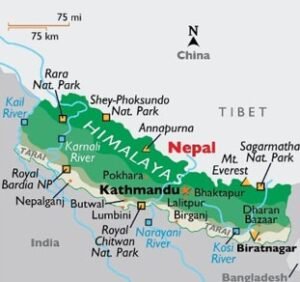
Why in News
-
Nepal is facing a political crisis after the resignation of PM K.P. Sharma Oli, violent protests, and the swearing-in of former Chief Justice Sushila Karki as interim PM.
-
This churn presents a strategic test for India’s Neighbourhood First Policy, as India must safeguard its interests while avoiding perceptions of interference, even as China deepens influence in Nepal.
Nepal’s Political Turmoil: A Test Case for India’s Neighbourhood First Policy
1. India–Nepal Relations
-
Geostrategic Importance
-
-
India shares a 1,770–2,000 km open border with Nepal.
-
Free movement of goods and people means political instability directly impacts Indian security.
-
-
Cultural and Civilisational Ties
-
-
Shared Hindu–Buddhist heritage.
-
Strong people-to-people links, especially with Madhesi population.
-
Gorkha regiments serve in the Indian Army.
-
-
Economic Interdependence
-
-
India is Nepal’s largest trade partner and investor, accounting for about 60% of Nepal’s trade.
-
Supplies fuel, medicines, and electricity.
-
Major source of FDI.
-
-
Hydropower Diplomacy
-
-
Cross-border power trade agreements in place.
-
India invests in projects like Upper Karnali and Arun-III.
-
-
Security Stakes
-
-
Political vacuum may lead to:
-
Cross-border smuggling
-
Fake currency networks
-
Growing Chinese presence under the Belt and Road Initiative (BRI)
-
-
2. China’s Growing Footprint in Nepal
-
BRI Investments
-
-
Infrastructure projects like highways, airports, and Tibet–Kathmandu railway.
-
-
Political Leverage
-
-
Beijing maintains ties with all major Nepali political parties.
-
Has mediated intra-party disputes, for example in the CPN.
-
-
Soft Power Expansion
-
-
Promotion of Chinese language.
-
Confucius Institutes, scholarships, and media outreach.
-
-
Security Concerns for India
-
-
Chinese presence near the Siliguri Corridor (Chicken’s Neck) raises alarms.
-
3. Concerns for India
-
Political Instability
-
-
Nepal has had 14 governments in 17 years.
-
Frequent coalition collapses disrupt bilateral cooperation.
-
-
Anti-India Sentiment
-
-
Rooted in events like the 2015 blockade.
-
Perceptions of Indian interference fuel mistrust, especially among youth.
-
-
China Factor
-
-
Beijing gaining strategic depth in Himalayan geopolitics.
-
-
Border Management Issues
-
-
Open border facilitates:
-
Illegal migration
-
Arms smuggling
-
Possible terror infiltration
-
-
-
Economic Fallout
-
-
Crisis threatens India-funded projects like:
-
Rail links
-
Integrated Check Posts (ICPs)
-
Energy corridors
-
-
4. Challenges for India
-
Balancing Engagement
-
-
Over-engagement creates “big brother” image.
-
Under-engagement leaves space for China.
-
-
Youth Disconnect
-
-
Post-monarchy generation (Gen Z) influenced by anti-India narratives.
-
-
Federal Politics
-
-
Need to engage beyond Kathmandu with provinces, Madhes leaders, and new political actors.
-
-
Economic Vulnerabilities
-
-
Political instability affects:
-
Border trade
-
Cross-border hydropower projects
-
Remittance flows
-
-
-
Security and Refugee Risks
-
-
Refugee influx likely if crisis escalates.
-
Growing space for Chinese intelligence activities.
-
5. Way Forward for India
-
Diplomatic Engagement
-
-
Strengthen ties with emerging leaders and provinces.
-
Use Track 1.5 and Track 2 dialogues.
-
-
Economic Diplomacy
-
-
Speed up border infrastructure and ICPs.
-
Rail connectivity projects: Jaynagar–Bardibas, Raxaul–Kathmandu.
-
-
Energy Cooperation
-
-
Expand hydropower projects.
-
Push for trilateral power trade between India, Nepal, and Bangladesh.
-
-
People-to-People Initiatives
-
-
Scholarships, cultural circuits like the Ramayana Circuit, and tourism links.
-
Counter anti-India narratives among youth.
-
-
Strategic Patience
-
-
Avoid overtly backing political personalities.
-
Focus on institutions, long-term partnerships, and resilience building.
-
Conclusion
-
Nepal’s turmoil is both a challenge and an opportunity for India’s Neighbourhood First Policy.
-
India must pursue a calibrated, multi-dimensional strategy that secures its interests without fuelling anti-India sentiment.
-
Building economic interdependence, youth-oriented outreach, and energy partnerships will be key.
-
A stable, democratic, and prosperous Nepal is ultimately in India’s best interest to maintain balance against China in the Himalayas.




